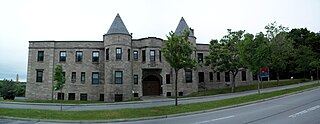Commandants
The regiment has had the following commandants. [3]
| Name | Year | Significance | Photo | |
|---|---|---|---|---|
| Lieutenant-Colonel (Brigadier-General) A.J. Bailey, DSO, OBE, ED, CD [4] | 1950–1951 |
| ||
| Lieutenant-Colonel (Colonel) E.G. Brooks, DSO, OBE, CD | 1951–1953 |
|  | |
| Lieutenant-Colonel R.G. Kingstone, CD | 1953–1956 | |||
| Lieutenant-Colonel (Colonel) J.L. Drewry, DSO, CD | 1956–1957 | Director of Royal Canadian Artillery (Nov 63 – Oct 65) [5] | ||
| Lieutenant-Colonel J.E. Pincock, CD | 1957–1959 | |||
| Lieutenant-Colonel G.N. Chambers, CD | 1959–1960 | |||
| Lieutenant-Colonel (Colonel) J.P. Beer, MBE, CD | 1961–1965 | Director of Royal Canadian Artillery (Oct 65 – Jul 69) [5] | ||
| Lieutenant-Colonel W.E. Sills CD | 1965–1967 | |||
| Lieutenant-Colonel J.G. Henderson CD | 1967–1969 | |||
| Lieutenant-Colonel J.A. Cotter, CD | 1969–1970 | |||
| Lieutenant-Colonel W.R. Dawes, CD | 1970–1972 | |||
| Lieutenant-Colonel H.R. Wheatley, CD | 1972–1974 | |||
| Lieutenant-Colonel D.E. Stothers, CD | 1974–1976 | |||
| Lieutenant-Colonel J.C. Fleming, CD | 1976–1978 | |||
| Lieutenant-Colonel C.J. Mialkowski, CD | 1978–1980 | |||
| Lieutenant-Colonel M.C. Brown, CD | 1980–1982 | |||
| Lieutenant-Colonel (Brigadier-General) Ernest Beno, OMM, CD | 1982–1984 |
| ||
| Lieutenant-Colonel R.B. Mitchell, CD | 1984–1986 | |||
| Lieutenant-Colonel (Colonel) Joseph D. Briscoe, OMM, CD [6] | 1986–1988 | |||
| Lieutenant-Colonel K.C. Hague, CD | 1988–1990 | |||
| Lieutenant-Colonel D.L. Ross, CD | 1990–1992 | |||
| Lieutenant-Colonel D.M. Chupick, CD | 1992–1994 | |||
| Lieutenant-Colonel (Colonel) D.D. Marshall, OMM, CD | 1994–1996 | Director of Royal Canadian Artillery (May 8 – May 10) [5] | ||
| Lieutenant-Colonel Stuart Beare, CMM, MSC, MSM, CD | 1996–1998 |
| ||
| Lieutenant-Colonel R.G. Davis, CD | 1998–2000 | |||
| Lieutenant-Colonel (Colonel) John David Ernest Crosman, CD | 2000–2002 | |||
| Lieutenant-Colonel (Brigadier-General) Kevin R. Cotten, OMM, CD | 2002–2003 |
| ||
| Lieutenant-Colonel (Major-General) Simon Charles Hetherington, OMM, MSC, CD | 2003–2006 |
|  | |
| Lieutenant-Colonel LCol S.A.A. Johnson, CD | 2006–2007 | |||
| Lieutenant-Colonel (Colonel) L.C. Dalton, CD | 2007–2009 | Director of Royal Canadian Artillery (Feb 12 – Mar 14) [5] | ||
| Lieutenant-Colonel (Brigadier-General) L.P. McGarry, MSM, CD | 2009–2010 | |||
| Lieutenant-Colonel (Colonel) G.W. Ivey, MSM, CD | 2010–2013 | |||
| Lieutenant-Colonel D. Bobbitt, CD | 2013–2014 | |||
| Lieutenant-Colonel (Brigadier-General) S.T. Hatton, MSM, CD | 2014–2016 |
| ||
| Lieutenant-Colonel (Colonel) J.G. Hampton, CD | 2016–2018 | |||
| Lieutenant-Colonel D.R. Matheson, CD | 2018–2020 | |||
| Lieutenant-Colonel (Colonel) S.A. Heer, MSM, CD | 2020–2022 | |||
| Lieutenant-Colonel J.D. Flanders, MSM, CD | 2022–2024 |  | ||
| Lieutenant-Colonel B.C. Insley, CD | 2024– |







